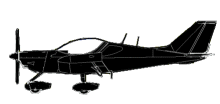
ASN Wikibase Occurrence # 122129
This information is added by users of ASN. Neither ASN nor the Flight Safety Foundation are responsible for the completeness or correctness of this information.
If you feel this information is incomplete or incorrect, you can submit corrected information.
| Date: | Friday 6 May 2011 |
| Time: | 23:28 |
| Type: |  CSA PiperSport |
| Owner/operator: | Private |
| Registration: | N420PS |
| MSN: | P1001009 |
| Total airframe hrs: | 100 hours |
| Engine model: | Rotax 912ULS |
| Fatalities: | Fatalities: 1 / Occupants: 1 |
| Aircraft damage: | Substantial |
| Category: | Accident |
| Location: | Spring Hill, near Hernando Co Airport, FL -
 United States of America United States of America
|
| Phase: | En route |
| Nature: | Ferry/positioning |
| Departure airport: | Fort Myers-Page Field, FL (FMY/KFMY) |
| Joliet Municipal Airport, IL (JOT/KJOT) | |
| Investigating agency: | NTSB |
| Confidence Rating: |
The pilot, who had previously provided flight instruction in the light sport airplane to its two principal owners, was flying it at night from Florida to Illinois. The pilot had flown commercially from Illinois to Florida earlier that day and had been offered lodging by the owners on several occasions but declined. The airplane was not approved for night operations due, in part, to a lack of interior lighting. For over an hour after takeoff, on a clear, dark night, the airplane was headed northbound in straight and level flight at 6,500 feet. The pilot, who had been in contact with an air traffic control facility, had been told to switch to a new radio frequency; afterward radar contact was lost and there were no distress calls from the pilot.
The airplane impacted wooded terrain and was mostly consumed by post-impact fire. All flight control surfaces were accounted for at the scene and no preexisting mechanical anomalies were found. There was no evidence of an in-flight fire and no evidence of the pilot attempting to use the whole-airplane ballistic parachute system.
The pilot was found about 1/3 mile away from the wreckage, about 600 feet to the right of the airplane's radar track. Numerous personal items were also located to the right of the airplane's radar track, with heavier items generally closer to the track than the lighter items. Shards of bubble-canopy glass and the canopy frame were found at the airplane's impact site, but no shards were noted in the vicinity of where the pilot or the personal items were found, indicating that the canopy was likely unlatched and open when the pilot and the other items exited the airplane.
Each seat of the two-seat airplane was equipped with a four-point restraint harness, with each harness having four identical belt adjusting mechanisms: two for the risers and two for the seatbelt portion of the harness. Except for a number of small pieces, both harnesses were almost entirely burned. One surviving piece, for adjusting either a riser or a seat belt portion of the harness, had distorted metal and pulled material, consistent with sudden, forceful loading. The top of the pilot's shoulders also exhibited bruising, indicative of a sudden loading while the harness risers were loosely in place. There were no marks on the pilot's frontal area to indicate that the seat belt portion of the harness was buckled at the time of the loading.
Ground testing revealed that access to the back shelf behind the seats would have been difficult to reach if the pilot had not unbuckled the seat belt portion of his restraint harness and loosened the risers. Thus, it is likely that the pilot tried to reach something on the back shelf. Then, at some point afterward, the canopy T-handle likely became unlatched, possibly having been caught by a loose right harness riser or a looped headset wire that plugged in next to the canopy handle. With a dark, noisy cockpit, the pilot likely then inadvertently applied rapid control inputs that resulted right-rolling, negative g-forces of sufficient intensity to eject him and the other personal items.
Probable Cause: The pilot's inadvertent application of control inputs that resulted in rapid, right-rolling, negative g-forces during night cruise flight and his subsequent ejection from the airplane. Contributing to the accident was the pilot's decision to fly at night in an airplane not approved for night flight, his unbuckling of the seat belt portion of the restraint harness, and the inadvertent opening of the airplane’s canopy.
Sources:
NTSB
Location
Revision history:
| Date/time | Contributor | Updates |
|---|---|---|
| 07-May-2011 06:35 | RobertMB | Added |
| 07-May-2011 14:24 | RobertMB | Updated [Time, Aircraft type, Registration, Cn, Operator, Location, Nature, Narrative, Plane category, ] |
| 11-May-2011 01:19 | vvvww | Updated [Operator, Source, Narrative] |
| 06-May-2012 17:26 | Geno | Updated [Time, Phase, Nature, Departure airport, Destination airport, Source, Narrative] |
| 21-Dec-2016 19:25 | ASN Update Bot | Updated [Time, Damage, Category, Investigating agency] |
| 27-Nov-2017 16:52 | ASN Update Bot | Updated [Operator, Other fatalities, Departure airport, Destination airport, Source, Narrative] |
| 21-Sep-2023 10:04 | Ron Averes | Updated [[Operator, Other fatalities, Departure airport, Destination airport, Source, Narrative]] |
Corrections or additions? ... Edit this accident description
The Aviation Safety Network is an exclusive service provided by:


 ©2024 Flight Safety Foundation
©2024 Flight Safety Foundation